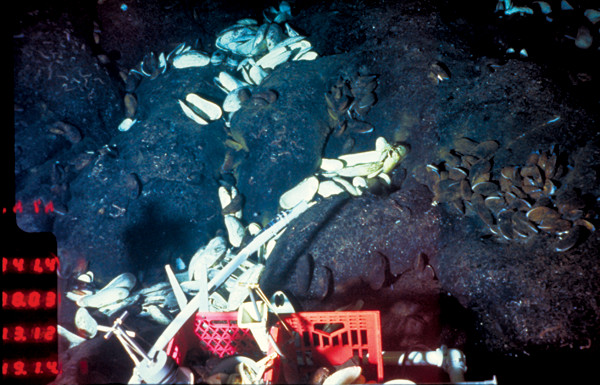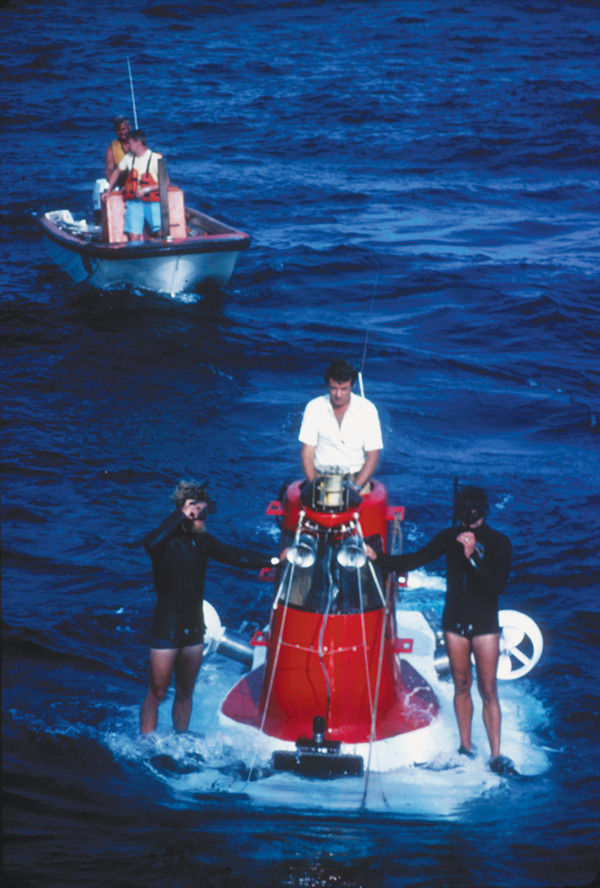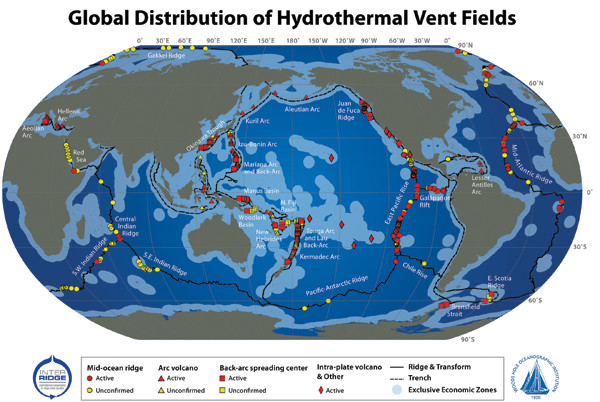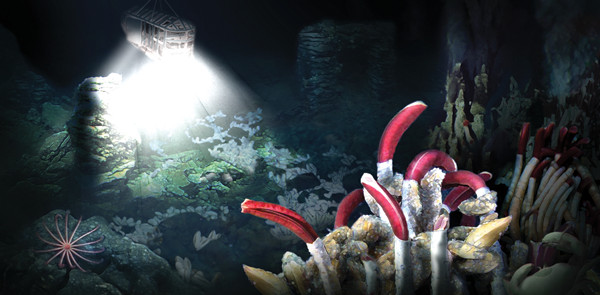
by Timothy Oleson Sunday, January 4, 2015

This image, taken on Feb. 17, 1977, records the discovery of deep-sea hydrothermal vents and dozens of previously unseen species of marine life. Credit: WHOI Archives ©Woods Hole Oceanographic Institution.
In early February 1977, as scientists aboard the research vessel (R/V) Knorr made their way across the Pacific waters off the northwest coast of South America, they had reason to suspect their expedition might find the success that had eluded others. Previous missions had identified their destination — a site on the ocean surface about 330 kilometers northeast of the Galápagos Islands, below which two tectonic plates rift apart — as a promising location from which to search for their intended target. Once there, the researchers would deploy a variety of tools, including manned and unmanned submersibles, to the ocean bottom in the hopes of directly spotting hydrothermal vents.
Such vents — where geothermally heated seawater spews from cracks in the seafloor back into the ocean — were theorized as a byproduct of plate tectonics. Given that plate tectonic theory itself had only gelled in the preceding couple of decades, geologists were eager to prove these vents existed. Earlier expeditions had documented warm-water anomalies, unusual rock and mineral deposits on the ocean floor, and other tantalizing evidence, all occurring near tectonically active areas as predicted. But no one had observed a vent up close.
Returning in 1977 to the Galápagos Rift, the scientists aboard the Knorr would not be disappointed. Less than a week after arriving on the scene, researchers searching the deep from inside the submersible vehicle “Alvin” came upon a plume of hot water issuing from the seafloor. This was the definitive proof they’d been after. But it wasn’t the only cause for excitement. The scientists were greeted by another, wholly unexpected sight: life, and lots of it.

Scientists diving on the Galápagos Rift in the submersible Alvin in February 1977 discovered a type of ecosystem that subsists via chemosynthesis rather than photosynthesis; such an ecosystem was previously unknown on Earth. Credit: WHOI Archives ©Woods Hole Oceanographic Institution.
Early clues that geothermally heated waters circulated through oceanic crust and vented into the overlying ocean emerged in the mid-1960s from explorations in the Red Sea. Despite its name, the Red Sea is actually a young and growing ocean, bisected — much like the Atlantic — by a mid-ocean ridge, or spreading center, where magma from the mantle wells up and cools to form fresh oceanic crust.
Several research cruises detected anomalously warm waters at depth above the Red Sea Rift. And sediment samples pulled from the seafloor were found to be enriched in metals like copper, iron and manganese, suggesting localized sources that were somehow supplying the metals.
These findings prompted explorations of other mid-ocean ridge systems in the Atlantic and Pacific and turned up additional evidence of hydrothermal systems. Ubiquitous seafloor basalts showed signs of having been infiltrated and metamorphosed by water at high temperatures: Veins of white quartz and brown sulfides pierced the rock, and alteration minerals like chlorite and epidote lent greenish hues to the predominantly black basalt.
Measurements of heat flow through the ocean floor, taken by large probes sunk into the sediments, near active ridge systems also showed odd results. If heat were simply conducted through the crust from Earth’s interior to the oceans, measured heat flows should be highest along the axis of the ridge (directly above the magmatic heat source) and then decrease steadily away from it. But the pattern of decreasing heat flow proved irregular. In particular, it was quite a bit lower than expected along the ridge, suggesting that something other than conduction was also ferrying heat away from the spreading center.
With remotely sensed evidence for hydrothermal vents mounting, it was time for scientists to dive down and take a closer look.
One area that scientists focused their attention on after the early efforts in the Red Sea was the Galápagos Rift. This active east-west trending rift, more than 2,000 kilometers in length, separates the Cocos Plate to the north from the Nazca Plate to the south. (The Galápagos Islands themselves, and other nearby seamounts, are fed by volcanism from the Galápagos hot spot — a distinct feature, but one that affects the character of eruptions and seafloor topography along the spreading center near the hot spot.)
From 1966 to 1970, researchers from Scripps Institution of Oceanography made a series of visits to the rift, taking heat-flow measurements from aboard ships. They returned in 1972, equipped for the first time with a submersible vehicle called “Deep-Tow,” which could be towed above the seafloor by a surface ship. Outfitted with cameras and other sensors, it offered the scientists their first actual view of the ocean bottom near the Galápagos Rift. Photographs taken by Deep-Tow showed large circular mounds, some covered in what appeared to be light-colored mineral crusts. Water temperature and heat-flow measurements again gave anomalous readings. And sonobuoys even detected scores of small earthquakes occurring in the area of the warm waters.
Each of the lines of evidence offered glimpses of where hydrothermal vents might be found. In 1976, Scripps scientists went back again, turning up yet more clues. A narrow slice of water — slightly warmer and with different chemistry than the surrounding seawater — extended nearly 40 meters above a large fracture in the ocean bottom, which was photographed by Deep-Tow. Nearby, more rocks appeared to be covered with white and yellow crusts. Images showing empty clamshells strewn on the seafloor (with a beer can purportedly among them) also intrigued the researchers.
Meanwhile, as exploration of the Galápagos Rift had progressed, another major research venture had been underway in the Atlantic. In the summer of 1974, and again in 1975, the ambitious French-American Mid-Ocean Undersea Study (FAMOUS) project brought together a small fleet of research vessels — including Alvin along with two French manned submersibles — to explore a section of the Mid-Atlantic Ridge southwest of the Azores.
For the first time, researchers dove to the heart of an underwater tectonic rift, observing the newly formed sheets and pillows of basalt that emerged. Despite hours of firsthand observation, tens of thousands of photos snapped and many measurements and rock samples collected, a direct view of vents in action again proved elusive. However, FAMOUS succeeded in proving the capability and utility of using manned submersibles to explore rift systems. And it wasn’t long before a new expedition would bring Alvin to the Pacific to search through the multitude of hydrothermal hints at the Galápagos Rift.

Since their discovery in 1977, more than 500 active hydrothermal vent fields have been located around the world. Credit: S. Beaulieu, K. Joyce, and S.A. Soule (WHOI), 2010.
On Feb. 12, 1977, the R/V Knorr, after venturing west from the Panama Canal, reached its destination northeast of the Galápagos Islands. On board were the expedition’s leaders, Richard Von Herzen and Robert Ballard from Woods Hole Oceanographic Institution, along with a team of geoscientists and crew. With the help of detailed bathymetric maps and ocean-bottom transponders, the team determined its precise location over the rift before lowering the unmanned Acoustically Navigated Geological Underwater Survey (ANGUS) down for a scouting mission on Feb. 15.
Hovering just meters above the seafloor, ANGUS measured temperatures and snapped 3,000 photographs of the bottom — one every 10 seconds — as it was slowly towed along for 16 kilometers. Halfway into the 12-hour foray, ANGUS detected a jump in water temperature. It lasted less than three minutes before the temperature returned to normal — about 2 degrees Celsius — but it was enough to excite scientists aboard the Knorr, who noted the time and location of the signal.
Once ANGUS was retrieved and its film removed and processed, the team began scanning through the photographs sequentially. In frame after frame, the scientists saw “an endless variety of sculptured pillow [lava] forms,” Ballard recounted in an article he penned for Oceanus Magazine later in 1977. Slowly, they made their way to the shots corresponding with the temperature jump.
“The photograph taken just seconds before the temperature anomaly showed only barren, fresh-looking lava terrain,” Ballard wrote. “But for thirteen frames (the length of the anomaly), the lava flow was covered with hundreds of white clams and brown mussel shells. This dense accumulation, never seen before in the deep sea, quickly appeared through a cloud of misty blue water and then disappeared from view.”
Not wasting time, Alvin was prepped for its first dive into the Galápagos Rift. On Feb. 17, it descended 2.5 kilometers down to the ridge, carrying pilot Jack Donnelly along with scientists John Corliss from Oregon State University and Tjeerd van Andel from Stanford University. At the bottom, the trio patrolled toward the area of the temperature anomaly, peering through the submersible’s windows at the desolate landscape below them.
When they reached their target, they “entered another world,” Ballard recalled. “Coming out of small cracks cutting across the lava terrain was warm, shimmering water that quickly turned a cloudy blue as manganese and other chemicals in solution began to precipitate out.” The team had spotted the proof of hydrothermal vents they’d been looking for. “But even more interesting,” he noted, was the “dense biological community living in and around the vents.”

Artist's illustration of the towed camera sled ANGUS, which played a key role in the discovery of hydrothermal vents, vent organisms such as giant clams and tubeworms, and in 1979, the first "black smoker" vents. Credit: Kathleen Cantner, AGI.
Coming upon a colony of 30-centimeter-long white clams, Corliss is said to have called up to his graduate student at the surface: “Isn’t the deep ocean supposed to be like a desert? … Well, there’s all these animals down here.” Over the course of two dozen dives to the ridge that February and March, the team would document, in addition to clams and mussels, orange dandelion-like siphonophores, giant red tubeworms, blind white crabs and at least one purple octopus, among other animals. Not expecting to stumble upon such deep-dwelling life, the geoscientists (there were no biologists on the mission) did their best to collect specimens and preserve them. When the small supply of formaldehyde aboard ship was exhausted, the scientists used vodka as a preservative instead.
The team, in locating hydrothermal vents, paved the way for vastly expanded ideas about the bounds of life. Not only were there myriad new species waiting to be discovered, but at the time, all food chains were thought to be dependent, at their base, on photosynthesis and the sun. The deep-ocean life that was known relied on the remains of dead photosynthetic plankton and larger animals that sank through the water column.
The basis of the vent food chains, it was later unraveled, was chemosynthesis. Predators subsisted on microbes and other organisms that made meals out of chemicals like hydrogen sulfide in the hot fluids pouring from the vents, as well the subsequent minerals that precipitated out of the fluids when they came in contact with cold seawater — all without the aid of sunlight.
The findings of the 1977 mission also allowed scientists to better address major unresolved questions in earth science. Heat transport from Earth’s interior as well as ocean chemistry, for instance, could be better explained with the understanding that cold seawater circulated through warm, fresh crust near spreading centers. In the process, the water — superheated to temperatures approaching 400 degrees Celsius — deposited some minerals while leaching others. Vent systems also began to make sense as the origin of massive, ophiolite-associated metal ore deposits on land.
Numerous subsequent explorations and research cruises have since carried on studying the unique geology, chemistry and life of hydrothermal vent systems. A return mission to the Galápagos Rift in spring 1979 brought to the site the first biologists, who began thoroughly cataloging the array of animals thriving there. Later that year, researchers in Alvin spotted the first “black smoker,” a vent belching a dark plume of sulfide-laden water, on a section of the East Pacific Rise near the Gulf of California.
To date, more than 500 active hydrothermal vent fields have been located. And with so much seafloor left to search, and academic — and now commercial — explorations ongoing, there may be many more discovered.
© 2008-2021. All rights reserved. Any copying, redistribution or retransmission of any of the contents of this service without the expressed written permission of the American Geosciences Institute is expressly prohibited. Click here for all copyright requests.